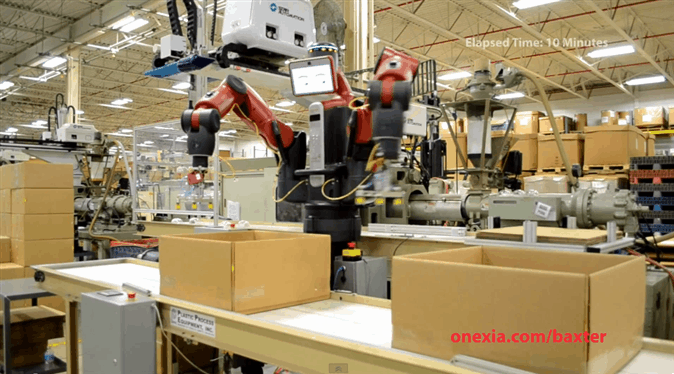Baxter: The Blue-Collar Robot
Baxter is the first-generation of robots that ordinary people can interact with in an industrial setting. They cost far less than most industrial robots partly because the software it uses runs off an ordinary personal computer.
What makes Baxter unique and particularly user-friendly are some of the following features:
- Facial expressions that show where the robot is looking and how it “feels.” The sonar sensors around its crown can detect the location of people nearby.
- Hands-on training: factory-floor workers can teach the robot to perform a task by first moving its arms to demonstrate the behavior; workers can access more features using buttons and dials on the robot’s forearms.
- Force feedback: the robot moves gently and has sensors around its joints that can detect collisions then instantly reduce the force of an impact.
- Double vision: it has cameras for eyes and also around its wrists so it can look what it’s handling up close.
Deep Learning
Deep-learning is an advanced technology that allows machines to identify patterns such as sounds, images, and other data, using multiple layers of neural networks. The breakthrough was made possible by improved learning algorithms and greater computer power in recent years. It’s the next step in artificial intelligence, or AI, which seeks to mimic the intuitive nature of our brains. It allows computers to identify speech and distinguish objects more accurately.
Android voice recognition
Microsoft’s Chief Research Officer Rick Rashid said at a recent conference in China that the previous method of voice recognition had an error rate of 20 to 25 percent. Deep neural networks reduce the error rate down to roughly 15 percent or less. The technology has been adopted on Android’s latest mobile software.
YouTube object identification and classification
Deep-learning also allows researchers to train machines to recognize objects. According to a post on Google’s blog by software engineer Quoc Le, after showing the neural network 10 million unlabeled images from YouTube, it learned to categorize them into things like faces, cats, pedestrians, and other abstract concepts. The algorithm improved the recognition rate of these objects by 70 percent over previous methods.
Additive Manufacturing
There’s been a radical change by General Electric in its technology segment with the company’s decision to produce jet engine parts using 3D printing—a technique known as “additive manufacturing.”
3D printing, which builds objects by adding ultra-thin layers of material layer-by-layer, is not new, and many niche items such as medical implants have already been produced using the technology. But GE’s application is the first time it’s been adopted at an industrial level, which is expected to offer great commercial value.
There are many potential benefits of additive processing compared to conventional welding and casting techniques:
- Complex shapes can be made more precisely with minimal material waste.
- Production costs and time are reduced since the process is computer-automated.
- Parts are lighter which translates into significant fuel savings for airlines.
- There’s greater flexibility in making new shapes without the traditional constraint of existing manufacturing configurations.
GE engineers are also exploring other materials, hoping that in the future, multiple parts of alloys can be made directly into a single unit.
Memory Implants
For more than two decades, Theodore Berger, a biomedical engineer and neuroscientists at the University of Southern California in Los Angeles, has been trying to design silicon chips that can replace damaged nerve tissue in the brain to improve people’s memory.
According to an interview conducted by Jon Cohen for Science journal, Berger’s colleagues thought he was crazy because the device is supposed to simulate how neurons process signals—in ways that will work for any brain.
Experiments have been conducted on animals to study what signals are responsible for forming long-term memories in the hippocampus. According to Berger, his team might have found the code, but the model may only work in limited situations.
Berger shed some light on the potential of creating memory implants by giving examples of existing technologies such as hearing aids that work by converting sound into electrical signals and sending them to the auditory nerve. Also, people that are paralyzed can now move robotic arms with their thoughts. There are also signs of success in artificial retinas for blind people. Nonetheless, he admits that manipulating and restoring a form of cognition such as memories would be far more difficult.
Supergrids
For the past century, AC power lines have been used on transmission grids even though they cannot transmit electricity as far as DC lines. This is because DC power could only be delivered via point-to-point transmission—not the integrated networks needed for stable electricity transmission.
A Swiss multinational corporation specializing in power and automation technologies, ABB Group, developed a high power DC circuit breaker that overcame this limitation by disconnecting problematic grid lines.
The circuit-breakers not only enable DC lines to form grids over long distances, but even across continents, including remote places with abundant renewable energy sources.
This means the usage of power can be averaged out by delivering renewable energies from areas with plenty of sunshine or wind to areas without.
According to Kevin Bullis, senior editor for energy of MIT Technology Review, this technology may even replace natural resources such as fossil fuels.





